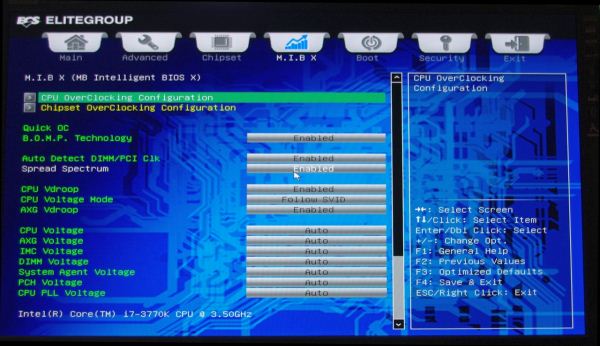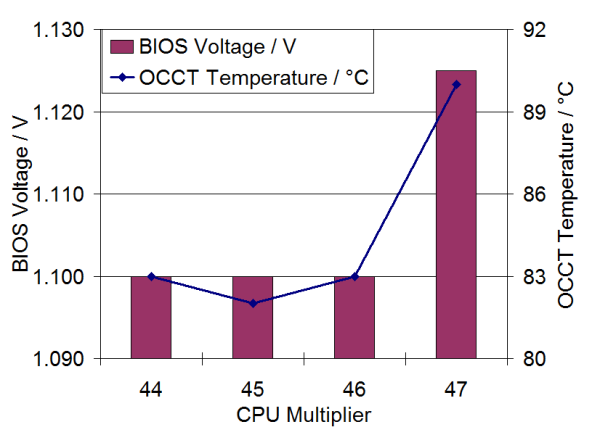Four Multi-GPU Z77 Boards from $280-$350 - PLX PEX 8747 featuring Gigabyte, ASRock, ECS and EVGA
by Ian Cutress on August 22, 2012 9:15 AM ESTECS Z77H2-AX Overclocking
Note: Ivy Bridge does not overclock like Sandy Bridge. For a detailed report on the effect of voltage on Ivy Bridge (and thus temperatures and power draw), please read Undervolting and Overclocking on Ivy Bridge.
Experience with ECS Z77H2-AX
Previous overclocking attempts on ECS motherboards have not entirely been successful – the name ECS does not exactly scream with an overclocking heritage. If your company background is based in OEM and B2B sales, overclocking expertise is probably not at the front of the mind when a motherboard is made. Despite this, ECS recently paired up with overclocking league website HWBOT as a sponsor and has run competitions for users using ECS motherboards as well as users to win ECS motherboards. Results in these competitions were a little mixed, with the winners having to modify the motherboards physically to reach the best scores. No doubt ECS learned a lot from the competition, as well as invested in the winners via consultancy regarding overclocking.
To put this into perspective, the ECS Z77H2-AX I had in for review overclocked very easily on the CPU, hitting 4.7 GHz at 1.200 volts (OS at full CPU loading) similar to most of the other boards in our testing. With regards memory, we had issues running our very aggressive DDR3-2400 9-11-11 kit at XMP – no matter our timings or voltages, the kit would not run at these settings. In the end, we settled for DDR3-2133 10-12-12, which could limit the motherboard in some of our benchmark suite.
Unfortunately, ECS has not decided to put in any automatic overclocking settings – no way of selecting a predefined set of options for your processor. The only way to overclock properly is through the BIOS, where all the options are in a trio of menus that are easy to navigate between. There is some overclocking software as part of the package, but it only allows BCLK adjustment.
One note I should point out – similar to the testing with the ASUS P8Z77-V Premium, during the testing of this motherboard we had an uncommonly bright and warm day, causing ambient temperatures to raise from 15°C to 25°C, and humidity to also rise. As a result, overclocking on this system hit its peak earlier than in other environments. Unfortunately it is not common for residential properties in the UK to have air conditioning either, so we had to make do with an additional pair of powerful fans to aid cooling.
Methodology:
Our standard overclocking methodology is as follows. We select the automatic overclock options and test for stability with PovRay and OCCT to simulate high-end workloads. These stability tests aim to catch any immediate causes for memory or CPU errors.
For manual overclocks, based on the information gathered from previous testing, starts off at a nominal voltage and CPU multiplier, and the multiplier is increased until the stability tests are failed. The CPU voltage is increased gradually until the stability tests are passed, and the process repeated until the motherboard reduces the multiplier automatically (due to safety protocol) or the CPU temperature reaches a stupidly high level (100ºC+).
Our test bed is not in a case, which should push overclocks higher with fresher (cooler) air. We also are using Intel's All-in-one Liquid Cooler with its stock fan. This is a 120mm radiator liquid cooler, designed to mimic a medium-to-high end air cooler.
Manual Overclock:
To start with, we adjust the CPU multiplier to 44x and the CPU voltage in the BIOS to 1.100 volts as we have done in our other Z77 testing. With the ECS Z77H2-AX, we also adjusted the VDroop to disabled. In order to apply a fixed value for the voltage, the voltage mode was set to ‘Ignore SVID’.
At the 44x CPU multiplier, the system was stable at 1.100 volts showing 1.164 volts at load when VDroop was disabled. Peak temperatures observed were 82°C during PovRay and 83°C during OCCT.
At the 45x CPU multiplier, the system was stable at 1.100 volts showing 1.164 volts at load when VDroop was disabled. Peak temperatures observed were 81°C during PovRay and 82°C during OCCT.
At the 46x CPU multiplier, the system was stable at a minimum of 1.100 volts set in the BIOS, showing 1.164 volts at load when VDroop was disabled. Peak temperatures observed were 82°C during PovRay and 83°C during OCCT.
At the 47x CPU multiplier, the system was stable at a minimum of 1.125 volts set in the BIOS, showing 1.200 volts at load when VDroop was disabled. Peak temperatures observed were 87°C during PovRay and 90°C during OCCT.
Unfortunately we were not able to get the 48x multiplier stable, and at a BIOS voltage of 1.200 volts, we saw 1.272 volts on the CPU at load and 97°C during PovRay before the system reported a memory error.












24 Comments
View All Comments
goinginstyle - Thursday, August 23, 2012 - link
I tried the G1 Sniper 3 and returned it a few days later. The audio was a significant downgrade from the Assassin series, EFI is clunky at best and the board had serious problems with a GSKill 16GB 2666 kit, not to mention the lousy fan controls.Purchased a Maximus Formula V and never looked back as the EFI, Fan Controls, Clocking and Audio are much better in every way compared to the Sniper board. There is no way Gigabyte has brought better value than ASUS with the Z77 chipset. You get what you pay for and the GB is overpriced once you actually use the board and compare it to ASUS or even ASRock.
JohnBS - Thursday, November 1, 2012 - link
I am looking for a rock solid MB, so of course I turned to ASUS. However, the reviews from verified buyers showed multiple issues with 3.0 USB ports losing power, system instability after months of use, and multiple instances of the board not working in one or more memory slots. Bent pins from the factory and complete DOA issues as well. A few reports of complete failure when the Wi-Fi card was inserted, yet gone with the card removed. This was mainly the Maximus IV series. Then I thought I'd look into the Maximus V series, because I really wanted ASUS, and was kinda sad to read reviews. Same issues from verified buyers of the Maximus V, more so with the USB 3.0 problems and the Wi-Fi/Bluetooth add-on card failures. In common were multiple complaints about customer service.So I emailed the ASUS rep who was replying to everyone's post, with specific attention on the recurring problems and how I was concerned about buying a MB. I got the email back, stating they were aware of the recurring problems listed on the user reviews, but that they are isolated occurrences.
I really need a rock solid x16 x 2 pci-e mb right now, and that's why I'm still searching. I'm planning on overclocking an i7-2700k with an gtx 690 and a 120z monitor for high res gaming. The sniper 3 looks good, but the front audio plug reaching the board's bottom audio header might be something I can't work around.
Just want something reliable. If there's a known issue, I'm always in that percentile that gets hit with the RMA process. I'm trying so hard to avoid that.
(Went with 690 instead of dual 680 for heat, noise, power draw considerations).
jonjonjonj - Friday, October 26, 2012 - link
you mean gigabyte in the evga conclusion?"the EVGA does not keep pace with ASUS and EVGA even at stock speeds."
couchassault9001 - Friday, November 2, 2012 - link
So for gaming benchmarks is it correct that the cpu multipliers were at 40 on the g1.sniper and 36 on the evga? if so it seems to be a rather unfair comparison. Being that the sniper cpu is running 11% fasterI'd be amazed if someone was looking at these boards with no intent to overclock like crazy, as i'm trying to decide between these 2 boards myself, and i'm sure i'll be pushing my 3770k as far as it will go.
The evga consumed ~8% less power than the sniper under load.
dirt 3 showed a 9% frame rate drop in the frame rate going from g1 to evga. metro 2033 showed a 3.6% drop in frame rate going from g1 to evga. Both of these are on the 4 7970 benchmarks. the 3 and below the gap is much tighter with it being under 1% with one card.
I know this may be nit picking to some, but i plan on running 5760x1080 3d so 4 7970 performance on a i7-3770k is exactly what i'm looking at.